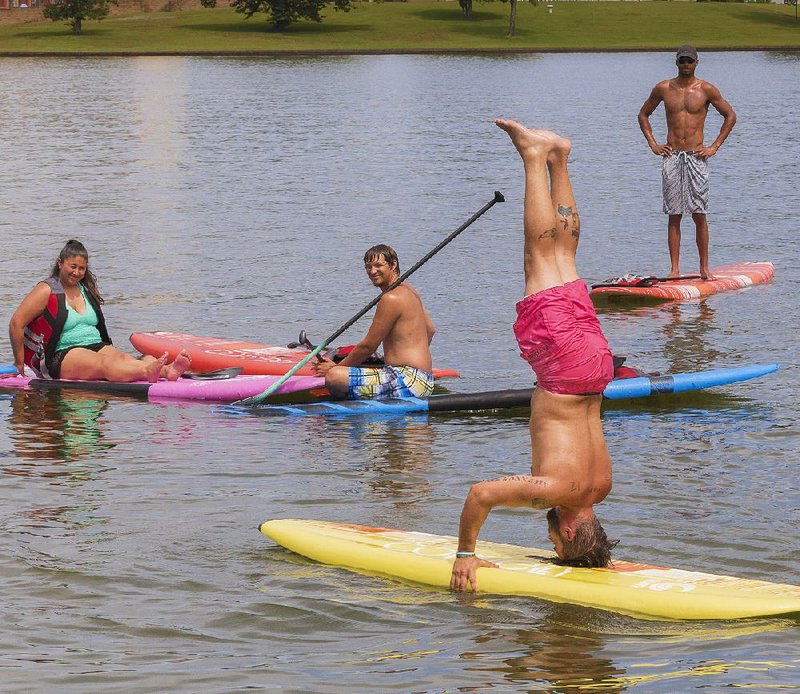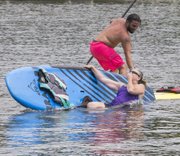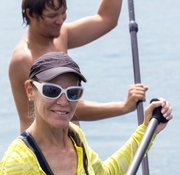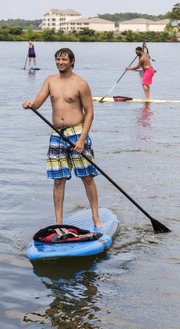T.J. Griffith knows fitness.
The physical education instructor at National Park College in Hot Springs has taught classes at gyms around the state for three decades. She has degrees in education and physical education. She even has her own fitness video, T.J.'s Power Hour.
Lately, she has put her students on stand-up paddleboards.
T.J. is for Tammy Jo, and stand-up paddleboarding is better known by its snappy acronym, SUP. This relatively new form of water recreation involves standing on a surfboardlike board between 9 and 12 feet long, and using a long paddle for propulsion through water.
She says the activity strengthens hips, knees, ankles, core muscles and the back, and provides a strong cardiovascular endurance workout. It was developed in Hawaii and popularized in California shortly after the turn of the millennium by big-wave surfer Laird Hamilton. It has spread to freshwater lakes and even rivers across the country.
SUP had the most first-time participants of any outdoor recreational sport in the nation in 2012, according to a 2013 report by the Outdoor Industry Association, a trade research and advocacy nonprofit. More than half who did SUP in 2012 were trying it for the first time, according to the study, and the median age of participants was 28. The data was gathered through 42,000 individual and household online surveys.
The activity is catching on more slowly in Arkansas, despite its abundance of lakes and rivers, enthusiasts say. But there are pockets of activity in southwestern, central and Northwest Arkansas.
Griffith, one of the few SUP instructors in the state, has an almost mystical belief in the power of the activity. That's why for three days a week this spring, she could be found on Lake Hamilton near Hot Springs,h̶e̶r̶ ̶L̶a̶b̶r̶a̶d̶o̶r̶ ̶r̶e̶t̶r̶i̶e̶v̶e̶r̶,̶ ̶R̶i̶v̶e̶r̶,̶ ̶s̶t̶a̶n̶d̶i̶n̶g̶ ̶b̶e̶t̶w̶e̶e̶n̶ ̶h̶e̶r̶ ̶l̶e̶g̶s̶,̶* teaching the state's first for-credit PE course in paddleboarding.
"My kids never miss a class," she says.
The thing about paddling a flat board is you start to wonder what else you can do on it. Griffith's class does Pilates, headstands, burpees; it's bootcamp on the Hamilton. While one might think only sporty students sign up, she says, that's not the case.
"You know what's so cool about it, usually it's my nonathletic ones that do it," Griffith says. "And they improve a lot. At first they fall off, fall off. As the weeks go on, they get really good."
To chart her students' progress, she tests them at the beginning and end of the semester for various fitness indicators. "Believe it or not, they do lose some weight," Griffith says. "If I can just get 'em hooked on water, and lose the sodas, they'll be good."
On most mornings and afternoons when the weather is nice, Little Rock resident Jo Ann Camp can be found teaching yoga classes: on central Arkansas lakes, above about 15 feet of water.
Camp, a Forrest City native, was teaching yoga in Dallas three years ago when she discovered a studio teaching SUP yoga on Lake Grapevine, about 25 miles northwest of downtown Dallas.
"I was like, I wanna do that," Camp says.
After taking a five-day SUP yoga certification course in Houston, during which she learned water safety rules, paddling techniques, CPR and how to set up an anchor system and tie safety knots, Camp took her new skills to Little Rock to start SUP Yoga 501.
The first summer, she averaged three to six students per class, going out on lakes Norrell and Sylvia. Students pay $30 per class ($25 if they supply a board). The only prerequisite for the class is the ability to swim. She believes that beginners benefit by starting to learn yoga on a board because it forces them to practice proper technique, whereas in a studio class students could overcompensate without tumbling into water.
First, students on their boards follow Camp to calm water. She then sets two 25-pound weights at each end of a 50-foot anchor line, and runs the line through carabiners attached to each board. Once secured, the class begins yoga.
The biggest difference between studio yoga and SUP yoga is "being out on the water," Camp says. "There's nothing better than that. The next [big difference] is the stability is not great, because you're on water. So it makes you a lot stronger, because your muscles are working in different ways."
In her second summer, she's averaging six to 10 students per class. Most of her weekend classes are sold out ahead of time, and she hosts private parties and events such as "Pinot and Paddle" (paddleboarding followed by a glass of wine) and a class for paddlers and their dogs dubbed "SUP and Pup." She provides life jackets for the dogs.
Camp, who owns a Golden Doodle, says, "They can jump in the water and jump back on the board. Most dogs really love it. They can drink water because it's right there."
SUP COMPETITION UNKNOWN
If racing is your game, it can be hard to find SUP competition in Arkansas. Phil Capel, who organized the Arkansas Canoe and Kayak Race in the Little Rock area before discontinuing it after 2013, says he's not aware of any SUP races in the state. His included a division for SUP racers.
"I see more people down there on Two Rivers [the confluence of the Arkansas and Little Maumelle rivers] where it's guarded from the currents," Capel says.
Jim Frank, owner of Ozark Outdoor Supply in Little Rock, says a dearth of clean, swimmable bodies of water in central Arkansas prevents some from getting out on paddleboards. Lakes DeGray, Hamilton, Ouachita and Greers Ferry see plenty of activity. Most of the people he sees doing SUP are on the Little Maumelle or "Big" Maumelle rivers. Lake Maumelle doesn't allow paddleboarding.
He does see people fishing from paddleboards, sometimes with coolers as seats. The ability to stand while fishing is appealing, he said. Nonetheless, Frank is skeptical.
"Yeah, hook a fish, get pulled around would be fun," Frank says. "But the fish doesn't know where he's going. He's gonna pull you wherever ... under trees and weeds. Bad things live there. Wasps, snakes ... it can get real entertaining real quick. At least in a kayak you're sitting down, got access to the paddle easily, and you're not trying to balance.
"I could see myself falling out under a tree and finding myself face to face with a water moccasin, and then it's, 'OK, who's gonna win?'"
One cool new addition to the sport he sees? The Hobie Eclipse, which operates "like a StairMaster on a paddleboard," propelling the board through the motion of climbing.
Most paddleboards drift because paddling on each side pulls the board off center. "This one you just grab on handlebars and it'll start to boogie," he says.
KEPT ISLAND LIFESTYLE
Melody Elliott may have left Hawaii, but the island lifestyle traveled with the 52-year-old mother of three, grandmother of four. Around Eureka Springs' steep hills, she can be found scooting on a longboard skateboard, always "looking for a thrill," she says.
The sport of stand-up paddleboarding settled over Elliott like a slow-rolling epiphany. Troubled by back pain from several years of restocking shelves in retail stores, she took up the sport as a salve during the final years of her husband's tour of duty with the Air Force in Hawaii. After he retired and they moved to Arkansas in 2011, she began paddling on Beaver Lake. Onlookers weren't quite sure what to make of her.
"'Wow, it looked like you were walking on water!'" she remembers hearing. "'We didn't know what you were doing.'
"I was like, 'This is my calling. I'm supposed to share this.'"
She started her business, SUP Outfitters, leading ecotours, corporate team-building and bachelorette parties, teaching SUP and SUP yoga, as well as renting and selling boards.
Making her passion into a business is a grind, Elliott says, complicated by paddleboarding's seasonal nature and still-developing appeal in Arkansas. But she stays busy most days.
One of her most rewarding experiences has been working with Ashley Rose, who was struggling to walk and speak after several brain surgeries. After more than a decade of holding a job and living independently, Rose in 2012 was forced to move in with her parents in Eureka Springs. Her long-term memory was gone. She couldn't walk without looking down. Two years later and still struggling, her doctor suggested she try paddleboarding.
Within a week, she noticed "huge improvement," Rose says. She gained enough strength to pick up the board. She began to regain her coordination. And she felt motivated to get out of bed and out of her house. "I was up, I was moving," Rose says.
Three weeks after the pair started paddleboarding, Rose's father "texted me, said it changed her life," Elliott says.
They continued paddling throughout summer 2014 and into the fall. In early 2015, Rose met a man online, and later that year they were married. Recently, the couple floated the Buffalo River, she on an inflatable paddleboard, he in a kayak.
"He is just a gem. I love him with all my heart," says Rose, who at 36 still faces significant memory and physical problems. "SUP has been a big huge relief because it has a lot of -- it's been very traumatizing, obviously, what has happened. And it has been a huge release to be able to just get out on the water. It's a very freeing place."
Count Elliott among those who believe the sport strengthens more than ankles, knees and backs.
"I'm not a doctor or anything," she says, "but I know it helps me. And like I said, I know it helped that young girl.
"She told me with her own words, 'You have forever changed my life.' I took that to heart. That's a beautiful thing."
ActiveStyle on 07/18/2016
*CORRECTION: National Park College physical education instructor T.J. Griffith teaches stand-up paddleboarding classes without her dog. This story misstated when her dog rides with her.






